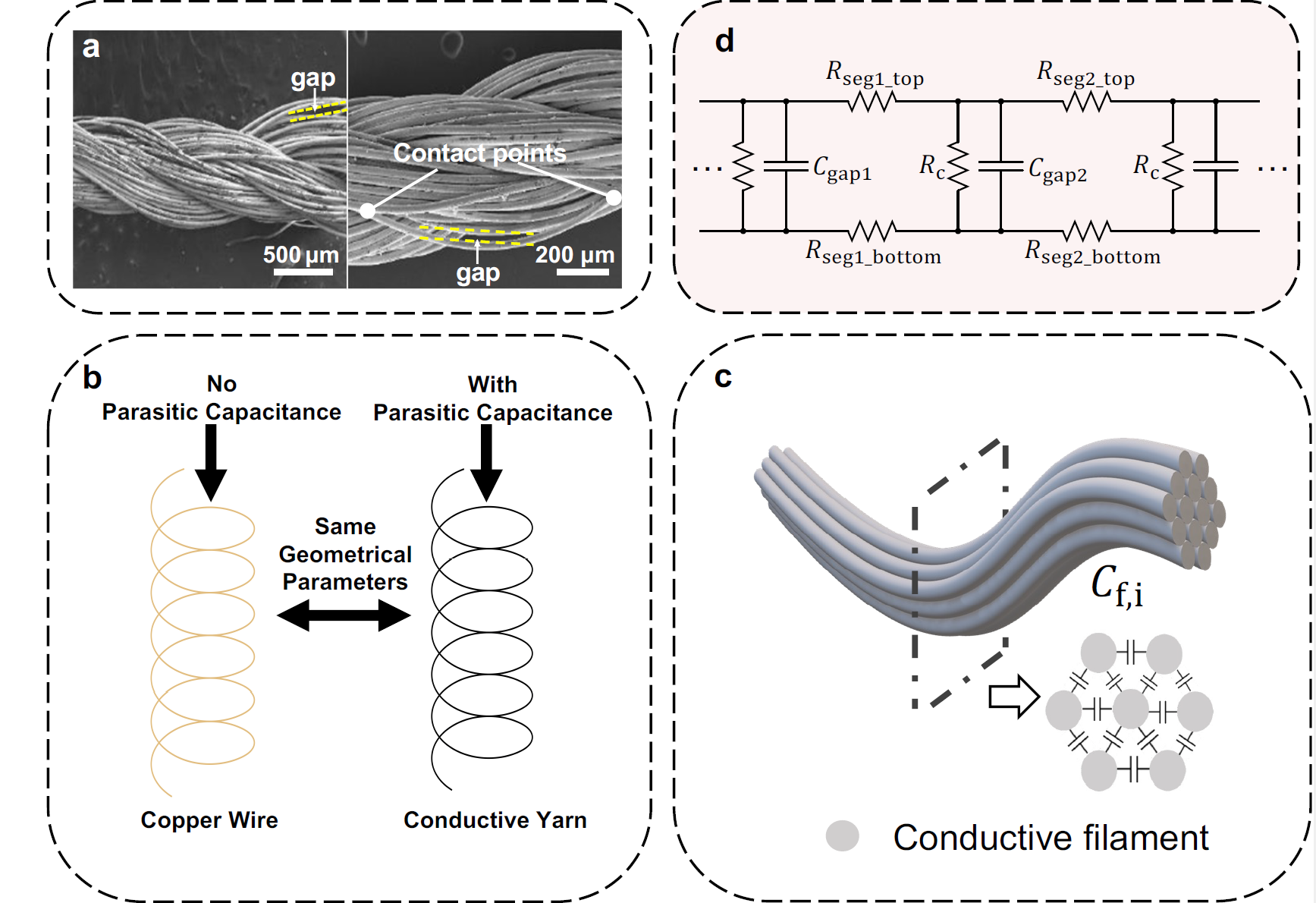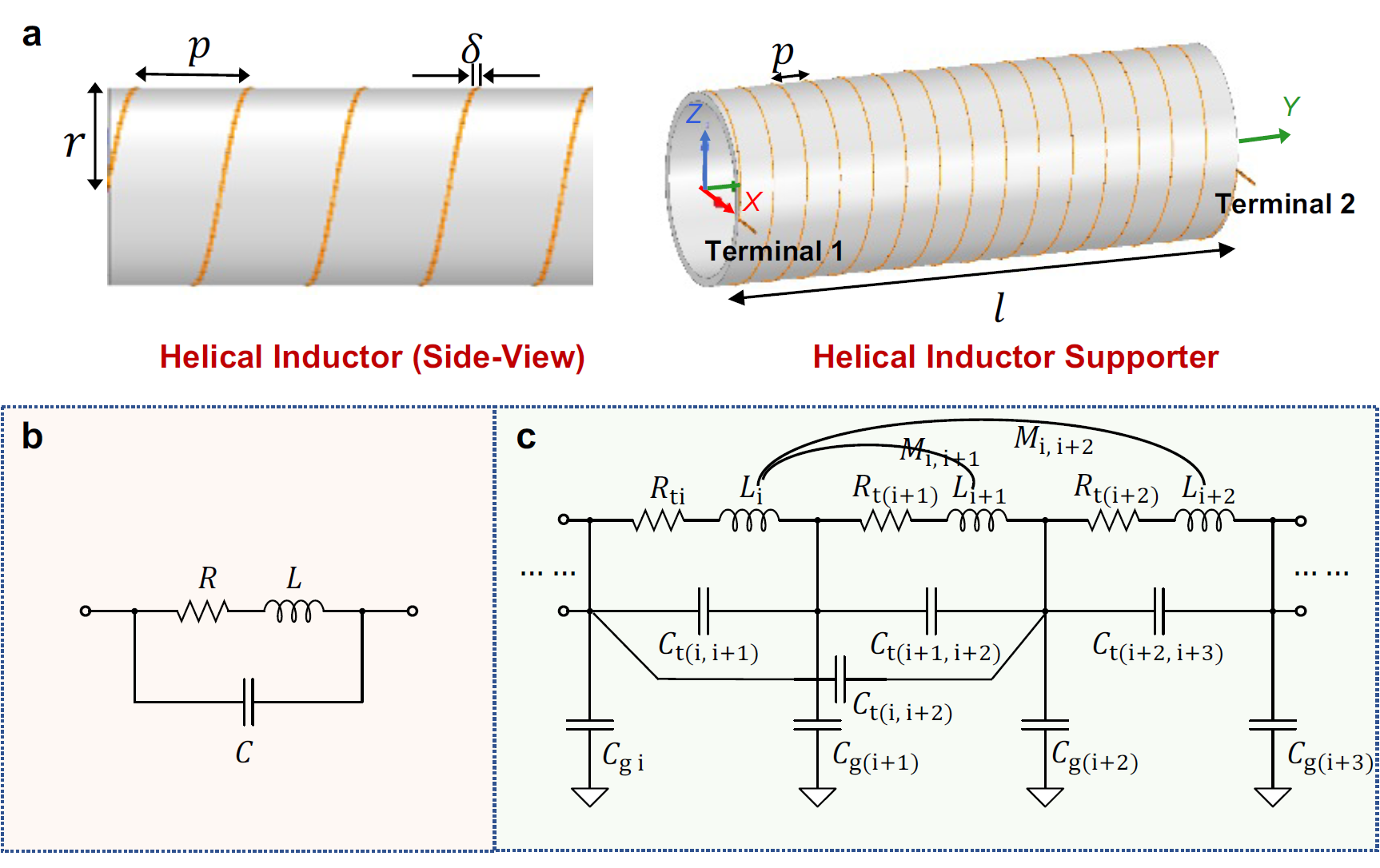Conductive yarns are an important component of electronic textile devices and have been widely used in smart clothing applications such as antennas, inductors, and interconnects, serving as feasible alternatives to traditional metal wires. However, the parasitic capacitance caused by the microstructure of conductive yarns has not been fully understood. This parasitic capacitance greatly affects the performance of devices in high-frequency applications.

Professor Terry Tao Ye from the Department of Electronic and Electrical Engineering (EEE) at the Southern University of Science and Technology (SUSTech) has recently led a research group that proposes a method for modeling and measuring the parasitic capacitance of conductive yarns, and systematically analyzes and quantifies the parasitic components of conductive yarns. This research is of great significance for evaluating the performance of electronic textile devices in high-frequency applications.
This research paper, entitled “Parasitic capacitance modeling and measurements of conductive yarns for e-textile devices,” has been published in Nature Communications.
The research team proposed a comprehensive and inter-turn model for a hollow spiral inductor constructed from conductive yarns and systematically analyzed and quantified the parasitic components of conductive yarns. By comparing the frequency response of inductors with the same structure based on copper and conductive yarns, the numerical value of the parasitic capacitance was extracted.
The experimental measurement results showed that the unit length parasitic capacitance of commercial conductive yarns ranged from 1 fF/cm to 3 fF/cm, depending on the microstructure of the yarn. These measurement results provided important quantitative estimates of the parasitic components of conductive yarns and valuable guidance for the design and characterization of electronic textile devices.
Conductive yarns can be divided into three types based on their constituent fibers: pure conductive metal fibers (such as stainless steel), intrinsic conductive polymer fibers, and conductive polymer composite fibers. By selecting different materials, conductive yarns with different mechanical and electrical properties can be designed to adapt to various applications. However, conductive yarns are not simple substitutes for traditional metal materials, as their inherent electrical and mechanical properties pose many design and manufacturing challenges. For example, conductive yarns typically have higher resistance than metal wires, and poor conductivity leads to increased energy loss and decreased quality factor. In addition, yarn-based structures cannot maintain higher-resolution fine geometries, so electronic textile devices must adopt rougher geometries and simpler construction methods.
In addition to the inherent resistance, conductive yarns also have inherent parasitic capacitance, which affects the high-frequency characteristics of electronic textile devices. This parasitic capacitance is caused by the twisted structure of the fibers in conductive yarns. Figure 1a shows the microstructure of a typical conductive yarn under a scanning electron microscope (SEM). The image shows that when the fibers are twisted into yarns, gaps are inevitably formed between the fibers. The fibers and gaps form a charge plate structure, resulting in parasitic capacitance.
Although previous studies have shown that parasitic capacitance may have important effects on electronic textile devices, no previous research has attempted to create circuit models and specifically estimate the parasitic capacitance of conductive yarns. However, it is also difficult to accurately quantify the value of parasitic capacitance using only a multimeter or network analyzer.

Figure 1. (a) Microstructure of the conductive yarns where gaps are formed between the twist filaments. (b) Estimation of the parasitic capacitance of conductive yarns through the comparison of the reactive performance of two helical inductors with the same geometrical parameters (one constructed from copper (left), one from conductive yarns (right)). (c) An equivalent circuit model of parasitic capacitances formed by the gaps between adjacent filaments. (d) Cross section of the conductive yarn: parasitic capacitances are uniformly distributed along the conductive yarns.
In this paper, the authors proposed a comprehensive model and an inter-turn model to estimate the parasitic capacitance of conductive yarns and presented a systematic approach to extract and estimate both forms of parasitic capacitance. This method requires the construction of two hollow spiral inductors with the same geometric parameters as shown in Figure 1b, including the same diameter, inter-turn spacing, and number of turns. One spiral inductor is wound with conductive yarn, while the other spiral inductor is wound with the same specification of copper wire. By comparing the resonance frequencies of these two spiral inductors, the overall parasitic capacitance of the yarn can be measured. In addition, by comparing the impedance curves of these two spiral inductors at different numbers of turns, the impedance curve of the equivalent circuit (Figure 2) can be fitted to extract the inter-turn parasitic capacitance of the conductive yarn. The overall parasitic capacitance and inter-turn parasitic capacitance are interrelated, further validating the accuracy of the parasitic capacitance model and extraction method presented in this work.

Figure 2. (a) Structure of single-layer air-core helical inductor. (b) Lump-sum equivalent circuit of the helical air-core inductor. (c) Turn-to-turn equivalent circuit model of the helical inductors.
Ziqi Qu, Zhechen Zhu, Yulong Liu, and Mengxia Yu from the Department of EEE at SUSTech are the co-authors of this paper. Professor Terry Tao Ye is the corresponding author.
This work was supported by the Key-Area Research and Development Program of Guangdong Province and the Shenzhen Science and Technology Program.
Paper link: https://doi.org/10.1038/s41467-023-38319-6
To read all stories about SUSTech science, subscribe to the monthly SUSTech Newsletter.
Proofread ByAdrian Cremin
Photo By